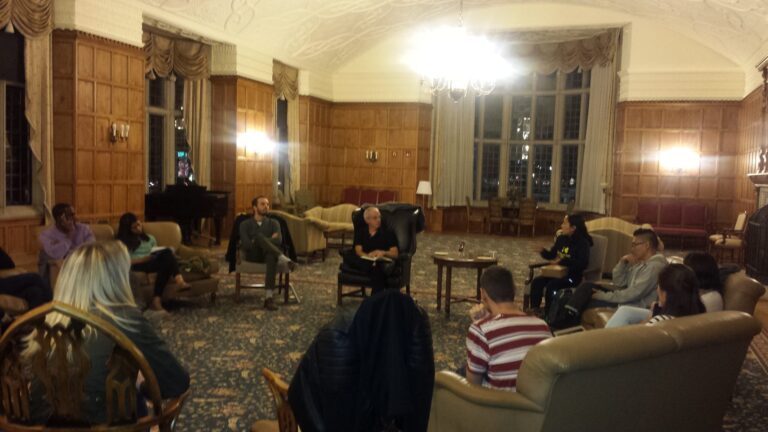All content categorized with: Uncategorized
Filter
Post List
Announcing the Vol. 22 Exec. Editorial Board
The Michigan Journal of Race & Law offers its CONGRATULATIONS to the Volume 22 Executive Editorial Board Editor-in-Chief Emmanuela Jean-Etienne Managing Editor Saeeda Joseph-Charles…Announcing: Vol. 22 Executive Editorial Board
The Michigan Journal of Race & Law offers its CONGRATULATIONS to the Volume 22 Executive Editorial Board Editor-in-Chief Emmanuela Jean-Etienne Managing Editor Saeeda Joseph-Charles…COMMENT: The Notario Problem
By Rebeca Ontiveros-Chavez Associate Editor, Vol. 21 Executive Articles Editor, Vol. 22 Latin Americans are the largest immigrant group in the United States.[1] Many have fled from persecution in their country and seek asylum.[2] Others are involuntarily brought as infants or children by their…
COMMENT: The Detroit Water Shut-Offs: An Alternative Approach to Analyzing the Constitutionality of the Detroit Water and Sewerage Department’s Shut-Off Policy
By Jackie Pilcowitz Associate Editor, Vol. 21 The City of Detroit is denying water to thousands of its residents. In the spring of 2014, the Detroit Water and Sewerage Department (DWSD) announced its plan to disconnect water service to Detroit residents with delinquent accounts — those who owed…COMMENT: Deportation of Possibly Exculpatory Witnesses Should be Per Se Bad Faith
By Andrew VanEgmond Associate Editor, Vol. 21 I. Deportation of Witnesses with Exculpatory Evidence: The Circuit Split The Circuit split analyzed in this Comment turns on whether or not to adopt a per se rule regarding government bad faith during a determination of whether the government’s deportation of…
COMMENT: Limited Voir Dire: An Inadequate Safeguard of the Constitutional Right to an Impartial Jury
By Austin Webbert Associate Editor, Vol. 21 Last term the Supreme Court was indirectly confronted with the specter of juror racial bias and its threat to the constitutional right to an impartial jury.[1] Warger v. Shauers, 135 S. Ct. 521 (2014). While the Court ultimately sidestepped the issue,…How the E-Government Can Save Money by Building Bridges Across the Digital Divide
As government agencies and federal aid recipients begin to build a presence online, they must recognize that language accessibility is morally required, fiscally responsible, and compulsory under federal civil rights law. This Note explores statutes, federal policies, and case law that purport to protect the rights of limited English proficient (“LEP”) individuals in cyberspace. The Note suggests reforms, policies, and programs that should be adopted by federal aid recipients to ensure that LEP individuals have meaningful access to online services.
The bifurcated Asian American response to Fisher II: controversy goes on
Last month, the author explored how Asian Americans view affirmative action policies. As the Supreme Court prepares to hear Fisher II, this issue reappeared to the author personally in her role as a student leader. By Jennifer Chun Associate Editor, Vol. 21 In 1997, Texas passed a law…
MJR&L Critical Race Theory Reading Groups Take Discussion to the Law School Community
As is tradition, MJR&L is once again producing Critical Race Theory reading groups at Michigan Law. These focused sessions allow students and faculty to dig deeply into an issue prompted by a short reading, free from the constraints and pressures of academic work. The first CRT session of the year…Disparaging Trademarks: Who Matters
For more than a century, non-majority groups have protested the use of trademarks comprised of or containing terms referencing the group—albeit for various reasons. Under the 1946 Lanham Act, Congress added a prohibition against registering disparaging trademarks, which could offer protection to non-majority groups targeted by the use of trademarks offensive to members of the group. The prohibition remained relatively unclear, however, and rarely applied in that context until a group of Native Americans petitioned to cancel the Washington NFL team’s trademarks as either scandalous, offensive to the general population, or disparaging, offensive to the referenced group. In clarifying the appropriate test for disparaging, however, the decision makers have overly analogizing the two prohibitions, rendering the disparaging trademark prohibition less effective in protecting non-majority groups from offensive trademarks.



